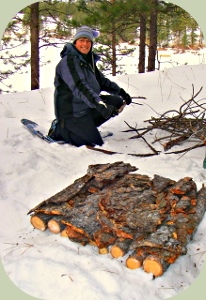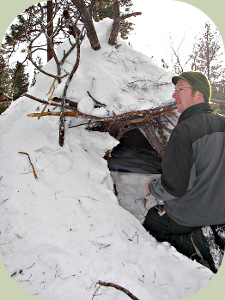Causes of Hypothermia, Hypothermia Symptoms & Preventing Hypothermia

What is Hypothermia?
When considering the causes of hypothermia, hypothermia symptoms and preventing hypothermia, the first place to start is in understanding the basics.
Hypothermia is a potentially dangerous state of the human body which occurs when heat is lost faster than it can be produced. It occurs when the normal body temperature - which is 98.6 degrees F for most people – drops below 95 degrees F.
As the body temperature declines the nervous system, heart and other organs struggle to function properly. If not treated, hypothermia can lead to the failure of vital organs and then, death.
Hypothermia Symptoms
Shivering is often the first of several hypothermia symptoms. Shivering generally occurs early on in the onset of hypothermia and may not be present as the condition becomes more acute.
The most famous hypothermia symptoms are the "fumbles, stumbles and mumbles." As the body temperature drops, the person's ability to perform coordinated tasks, walk smoothly, and talk coherently will decrease. The person may experience increased difficultly in thinking clearly and might make poor decisions. They may become sluggish, feel low on energy and have an indifference to their current condition.
As time continues, hypothermia symptoms will become increasingly more dangerous. The person will have a progressive loss of consciousness, might have a weak pulse and shallow breathing.
Additionally, a person who is experiencing symptoms of hypothermia is generally not aware of their condition due to the lack of clarity in their thinking. This is perhaps the greatest hazard in dealing with hypothermia while alone in the outdoors.
Causes of Hypothermia
The causes of hypothermia are mainly exposure to cold weather or cold water. Though it is possible for hypothermia to occur indoors, generally it is a much greater danger in the outdoors.
Exposure is one of the main causes of hypothermia and it can occur in a number of ways. One way is fall in to cold water, a classic example of which would be falling through ice.
Another of the causes of hypothermia is being unable to move to a warm and dry location and/or being unable to get out of wet clothing. Staying out in the cold too long is one of the common causes of hypothermia.
Wearing clothing that is inadequately warm for given weather conditions is another cause of hypothermia.
Preventing Hypothermia
It is helpful to consider preventing hypothermia before it occurs. Wear layers in colder conditions, especially loose, light-weight materials. Cotton loses most of its ability to hold in body heat when it is soaked and will speed heat loss, encouraging hypothermia. The best inner layers are made of silk, wool or polypropylene because they hold in body heat more effectively. For wind protection, water-repellent clothing is best as an outer layer.
If you are in the outdoors and do not have access to such materials, try stuffing your sweatshirt or jacket and pants with dry dead leaves or other debris. These can provide the dead air space needed for body heat retention. Pack in as much as you can fit until you can hardly stuff anymore in there.
Also, when using clothing in preventing hypothermia, remember to cover your head and extremities. Even if you do not wear hats or gloves very often, carry them with you during outings into the outdoors. Wool hats and wool gloves/mittens are reliably some of the warmest materials available.
When thinking about preventing and avoiding the causes of hypothermia, it is important to also remember that sweat can cause heat loss. When out in colder climates, limit or avoid activities that cause profuse sweating. If you are engaged in these activities, make sure to ventilate your clothing so that they do not become soaked in sweat.
Be More Prepared For Your Next Outdoor Adventure!

Don't leave home without knowing these six essential survival skills. Our free survival mini guide reveals the strategies of:
- Shelter & fire to prevent the number one cause of death
- Obtaining clean water to avoid life-threatening dehydration
- Common wild survival foods and other critical skills!

Treating Hypothermia
Generally speaking, when you find someone showing signs of hypothermia it is best to seek medical attention immediately. In emergency situations, especially in a survival situation, this might not be possible. Here are some considerations in treating hypothermia:
- If you have just arrived on the scene or are in a survival situation, assess the area carefully and consider any potenial risks and available resources. Some basic knowledge of survival skills can be extremely valuable. You can check out our article on basic survival skills here: Basic Survival Skills.
- If you notice or find a person showing signs of hypothermia, gently approach the person and handle them with care.
- Make them move only if necessary, as excessive movements in an acute case of hypothermia can cause cardiac arrest.
- Remove their wet clothing, but again minimize movement.
- Cover the person with dry coats or blankets with only the head exposed. If you are in the outdoors in an exposed or wet area, get them into a dry, sheltered spot. If there are none around, create one. In open areas, windbreaks can be made out of shrubs, rocks or grasses. Be creative and stay positively focused.
- Insulate them from the cold ground by laying them on their back on a blanket or other warm surface. Exposure to the cold ground can increase and even cause hypothermia. In a survival situation, consider cutting cattails, ferns, evergreen boughs or grasses and making a large pile of them to insulate the person with hypothermia from the ground. Since these materials will compress significantly under the weight of a person, make the pile of material at least 12 inches thick.
- Share body heat. Remove your clothing and provide skin-on-skin contact while wrapped in blankets or other warm, insulating materials. In a survival situation it can help to have a fire going before you do this, but remember not to put the person too near to the fire as it can cause cardiac arrest. Fire starting in a survival situation can be a challenge. Check out our primitive fire making articles here: Wilderness Survival Tips.
- Remember that you will not be any help if you also get hypothermia! Keep the causes of hypothermia in mind and keep yourself warm too. If in a survival situation, do whatever it takes to stay warm.
- If the person is able to swallow and is alert, provide them with some warm, non-caffeinated and non-alcoholic drink. Caffeine can affect the heart rate, and alcohol can also increase the rate of heat loss by dilating the blood vessels near the skin surface.
- You may also apply a warm, dry compress to the chest, groin or neck. Do not apply it on the arms or legs as this may cause cardiac arrest. Don't use hot water, a hot water bottle or heat lamp as extreme heat can also cause cardiac arrest.
Hypothermia is a potential hazard to your well-being when exploring the outdoors. But with an understanding of its symptoms and causes of hypothermia you can avoid having to experience it or treat it. The best treatment for hypothermia is through prevention. Remember to bundle up out there, stay dry and have fun!
A greater understanding of primitive survival skills such as shelter building and fire making can be a priceless asset to have when in the outdoors.
By the way, if you enjoyed this article then you'll love our survival mini guide. You'll discover six key strategies to staying alive in the outdoors plus often-overlooked survival tips. We're currently giving away free copies here.
Additional Resources:
Related Courses:


About the Author: Filip Tkaczyk is a periodic guest teacher at Alderleaf. He also wrote the field guide Tracks & Sign of Reptiles & Amphibians. Learn more about Filip Tkaczyk.
Return from Causes of Hypothermia to Wilderness Survival Articles
Is The Essential Wilderness Survival Skills Course Right for You? Take the "Online Survival Training Readiness" Quiz
See for yourself if this eye-opening course is a good fit for you. It takes just a few minutes! Get your Survival Training Readiness Score Now!

Grow Your Outdoor Skills! Get monthly updates on new wilderness skills, upcoming courses, and special opportunities. Join the free Alderleaf eNews and as a welcome gift you'll get a copy of our Mini Survival Guide.

 The Six Keys to Survival: Get a free copy of our survival mini-guide and monthly tips!
The Six Keys to Survival: Get a free copy of our survival mini-guide and monthly tips!
Learn more